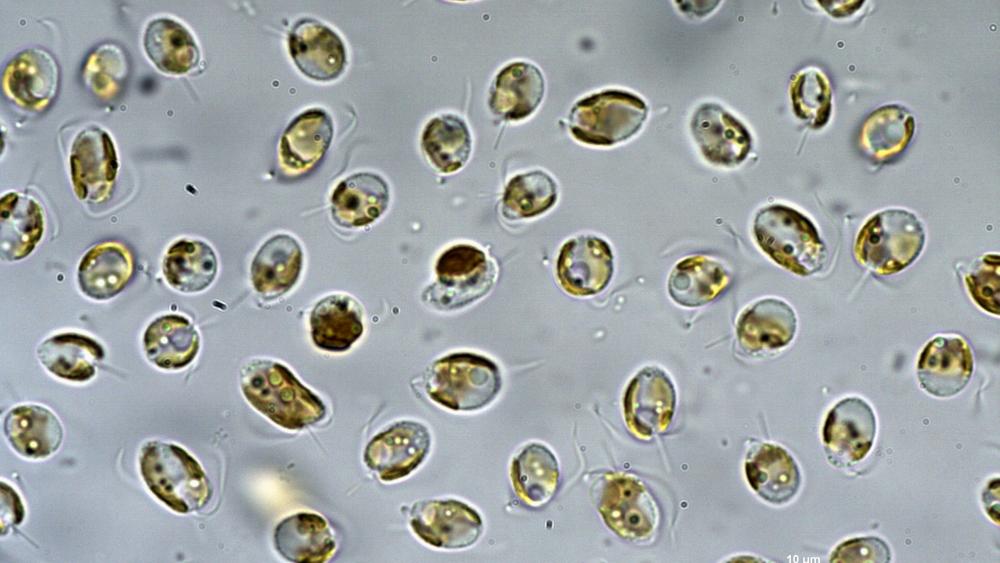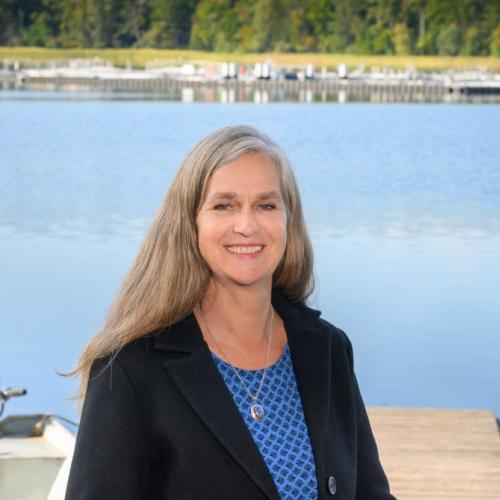
Prymnesium parvum cultures from the Oder River. | © Katrin Preuss/IGB
Description:
What is Prymnesium parvum?
Prymnesium parvum is a unicellular microalga that is 5 to 10 micrometres (µm) long and 4 to 7 µm wide.
Using its two flagella of equal length, the alga can actively move through water. It also has a holding organ, the so-called haptonema, with which it can attach itself to prey organisms and other surfaces.
There are at least 40 genetically distinct strains of Prymnesium parvum, which have different amounts of genetic material and produce specific toxins. The name “Prymnesium parvum” is therefore a collective term for very different strains or types of the genus Prymnesium. The genotype of Prymnesium that led to the devastating damage in the Oder River in the summer of 2022 belongs to the so-called B-type.
As is typical for plants, Prymnesium can feed autotrophically, i.e. by photosynthesis. However, this microalga can also feed on organic material (heterotrophically), in particular on other organisms. It is known that Prymnesium increasingly feeds heterotrophically when there is a lack of the nutrients nitrogen and phosphorus.

Prymnesium parvum is often referred to as ”golden alga“ in publications, although this name is also used as a collective term for other groups of algae with similar pigmentation. | Illustration: Christiane John
Distribution:
Where does Prymnesium parvum occur?
The alga is found worldwide in brackish waters, where mass developments with fish kills are regularly reported. It therefore belongs to the ecological group of brackish water algae. However, Prymnesium can also be found in the ocean and in fresh water, albeit in much lower concentrations. Occurrences have been documented in Europe, North America, South America, Australia and Asia. Prior to the environmental catastrophe in the Oder, Prymnesium had already caused massive fish kills on several occasions in highly saline reservoirs in the south of the USA, among other places.
The alga was already native to Europe before it was first found en masse in the Oder River in 2022. Toxic mass developments have occurred in Norwegian fjords, for example, but also in the increasingly saline River Thurne, England, and the Jasmund Bay (Jasmunder Bodden). However, unlike the Oder, these waters have a naturally high salt content. The only known mass development in a natural freshwater body outside the Oder river system has occurred in an industrially polluted river in the north-east of the USA.
Mass developments of planktonic algae require favourable growth conditions for several weeks. In free-flowing rivers that are not artificially dammed, mass developments are impossible, as the water in the rivers has usually already reached the sea by this time.
During the environmental disaster in the summer of 2022, the algae grew en masse in the Oder to more than 100 million cells per litre of river water, particularly in the Gliwice Canal and neighbouring reservoirs.
Since then, Prymnesium has become established in the Oder system. After the start of field surveys by IGB as part of the ODER~SO project in March 2023, Prymnesium was detected in low concentrations in the Oder, but the alga has not mass-proliferated since then. The maximum density in the section of river investigated in summer 2023 was only about one hundredth of the density in August 2022. Even if such Prymnesium concentrations are too low to cause mass mortality of fish or mussels, they may have a major impact on the growth and fitness of other organisms such as zooplankton.
In the summer of 2023, Prymnesium cells were also detected in individual samples from the waters of the Spree-Havel system, albeit at low densities. These corresponded to only around one thousandth of the algae density measured in the Oder in August 2022. Accordingly, no negative effects were observed there.
Prymnesium can, for example, pass unnoticed from one body of water to another via water birds, on boats, rubber boots or through fishing gear such as fishing rods or landing nets. It can even spread in aerosols, the smallest suspended particles in the air, due to their tiny size. The same applies to Prymnesium as to all microalgae: It can spread everywhere, but it cannot grow en masse under all conditions.
Growth conditions:
How does mass development of Prymnesium parvum occur?
According to current research, the rate at which Prymnesium can grow depends on at least six factors: the water retention time, the salinity, the light availability, the water temperature, the presence of algae viruses and the levels of nutrients such as nitrogen and phosphorus in the water. More precise parameters for the growth of the algae are still being researched.
Prymnesium tolerates salinity levels between 0.5 PSU (unit of measurement: Practical Salinity Unit) and 30 PSU. In laboratory tests, it cannot grow at a salinity of over 34 PSU, which is typically found in the open sea. According to previous studies at IGB, the strain from the Oder grows best at 2–5 PSU, while the salinity of the Oder without discharges would be below 0.5 PSU.
Depending on the salinity of the water, the alga will grow particularly quickly at water temperatures between 20 °C and 30 °C. However, many mass developments with toxin formation have already been observed at water temperatures between 7 °C and
15 °C, where growth takes longer.
Under ideal conditions, such as high salinity, plenty of light, warm water and sufficiently high levels of nitrogen and phosphorus, Prymnesium grows very rapidly: the algae then only need a few days to double their biomass. Such conditions favour the mass development of the algae.
Mass developments of Prymnesium have so far been documented in lakes and reservoirs with a salinity of 0.74–20 PSU, and in rivers with a salinity of 0.9–3 PSU. Prymnesium can proliferate in areas with calm flow such as reservoirs, but also to a lesser extent in free-flowing river sections. The water residence time or flow rate plays a key role in the growth and spread of the algae.
Fish die from lack of oxygen and circulatory failure after the toxin has destroyed their red blood cells. | © Luc De Meester/IGB
Toxicity:
What makes Prymnesium parvum so dangerous?
Under certain conditions, Prymnesium produces cytotoxins, so-called prymnesins, which damage or kill competing algae species, predators and other animals. Prymnesium benefits from the nutrients that are then released.
The prymnesins destroy the gills of aquatic organisms and then enter their blood and internal organs, which they decompose. Fish die from lack of oxygen and circulatory failure after the toxin has destroyed their red blood cells.
These toxins also kill mussels and gill-breathing aquatic snails. Little is known about how different groups of zooplankton – i.e. small animal organisms floating in the water – react to prymnesins, but this is being investigated. According to current knowledge, Prymnesium concentrations as low as 1 million cells/litre can already have negative effects on the growth and reproduction of zooplankton. Similarly, very little research been performed on amphibian larvae.
The question of the exact conditions under which the algae produce and release their toxin is the subject of ongoing research. Among other things, scientists are investigating possible correlations with the density of the Prymnesium bloom or the number of predators present. The influence of the nutrient levels or a sudden change in the salinity of the water is also being investigated.
It is already clear that the environmental conditions for the growth of the prymnesium parvum are different from those under which they become toxic.
Countermeasures:
How can toxic Prymnesium blooms in the Oder and other waters be prevented or contained?
Natural predators of Prymnesium – as of all planktonic algae – include predatory protozoa, rotifers, water fleas and mussels. In addition, parasites such as fungi or viruses can decimate a Prymnesium bloom. However, under favourable conditions, including suitable salt concentrations, Prymnesium will reproduce much faster than algae cells die, resulting in mass development.
Therefore, the most effective precautionary measure against further Prymnesium mass developments in the Oder would be to reduce the salinity of the river to a level that is less favourable for the brackish water alga Prymnesium – especially during the summer months. A threshold value for this does not yet exist, but is to be proposed on the basis of new studies.
Reducing concentrations of the plant nutrients phosphorus and nitrogen in the Oder River, which are mainly discharged via inadequately treated wastewater and through agriculture, would also reduce the risk of further Prymnesium mass developments, but this cannot be achieved in the short term.
The use of hydrogen peroxide and the precipitant ferric chloride to combat the mass development of Prymnesium was tested in Poland after the Oder disaster. According to reports, these measures can reduce Prymnesium density locally. However, IGB does not expect this to have a lasting effect, especially as it is not possible to combat the problem in flowing water due to the large quantities of chemicals required, and would have negative side effects on other aquatic organisms.
Like all algal blooms, those of Prymnesium require a long water residence time to develop. Algal blooms therefore occur in stagnant or slow-flowing tributaries and reservoirs. Combating them locally and not releasing them into the Oder can prevent disasters, but it does not eliminate their causes.
Prymnesium and algae monitoring in general, either by remote sensing and/or by taking samples in bodies of water, enables earlier warnings. However, the countermeasures and response options are limited.
In the event of toxic riverine disasters, riparian and floodplain waters play an important role as refugial and recolonisation habitats for riverine fauna. They provide fish fauna and other mobile organisms with access to refugia, spawning and nursery areas. Deepening the river bed through engineering measures counteracts lateral connectivity and contact with the tributaries is lost, especially during periods of low water in summer.
Deepening the Oder for navigation additionally impairs the river’s ability to clean itself by reducing the contact surfaces with the sediment. As a result, the Oder would become less resilient to pollution disasters and the effects of climate change. Near-natural or restored water bodies can cope better with future challenges. Purely technical solutions are expensive and inflexible. In contrast, the use of nature-based solutions can achieve considerable synergies between the protection and use of watercourses and their floodplains.














